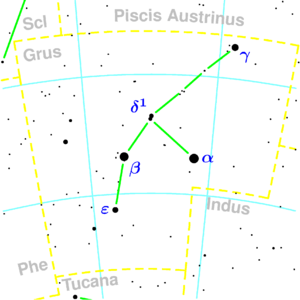 A fairly prominent constellation of the southern sky in the shape of an inverted cross, below the bright Fomalhaut of the Piscis Austrinus. With a little imagination in the distribution of the stars, we can see a flying crane with its legs spread back, neck stretched out and head held high. Only the northernmost part is visible in our evening sky. For observers with smaller binoculars, apart from a few binaries, the constellation is poor in objects, although for instruments with binoculars with a lens diameter of around 200 mm it has some nice extragalactic objects. In the northeastern part of the constellation, north of the star θ Gruis, there is a small group of 10th to 11th magnitude galaxies, most of which are spiral galaxies: NGC 7410, 7424, 7552 and 7590.
A fairly prominent constellation of the southern sky in the shape of an inverted cross, below the bright Fomalhaut of the Piscis Austrinus. With a little imagination in the distribution of the stars, we can see a flying crane with its legs spread back, neck stretched out and head held high. Only the northernmost part is visible in our evening sky. For observers with smaller binoculars, apart from a few binaries, the constellation is poor in objects, although for instruments with binoculars with a lens diameter of around 200 mm it has some nice extragalactic objects. In the northeastern part of the constellation, north of the star θ Gruis, there is a small group of 10th to 11th magnitude galaxies, most of which are spiral galaxies: NGC 7410, 7424, 7552 and 7590.
Alnair (α Gruis) - The brightest star in the constellation with a visual magnitude of 1.7. Its name means "bright star". It is a blue-white main sequence star 70 times more luminous than the Sun, located 60 light-years away. Among the trio of the brightest stars in the constellation, it is the closest to us. At an angular distance of 28.4", there is a faint companion with a magnitude of 11.8.
β Gru - The red giant irregularly varies in brightness from 2mag to 2.3mag. Its luminosity is approximately 800 times that of the Sun. It is located 200 light years away. In the eyepiece, it nicely contrasts with the blue-white star Alnair.
γ Gru - The blue giant is even brighter than the two previous stars. It is located 230 light-years away from us. Its visual magnitude in the sky is 3.2 mag.
δ Gru - Astronomický text:
A naked-eye distinguishable optical double star. The separation between the yellow 4mag and the red giant 4.1mag is 12 arcminutes. Both components are also doubled. In the first one, we can distinguish a companion with a brightness of 12.8mag at a distance of 5.6".
Překlad českých zkratek světových stran do angličtiny:
S - South Z - West J - East E - North
Překlad anglických zkratek světových stran do češtiny:
N - Sever (North) W - Západ (West) S - Jih (South) E - Východ (East)
θ Gru - A physical binary star, whose companions can be distinguished even in a small telescope at a separation of 14 arcseconds. They have magnitudes of 4.5 and 7.
μ Gru - Wide optical double star distinguishable with the naked eye. It consists of yellow giants with magnitudes of 4.8 and 5.1, located at a distance of 260 and 240 light years.
R a S Gru - Variable stars of the Mira Ceti type are observed in their maximum brightness. R Gruis changes its magnitude from 7.4 to 14.9 in a period of 332 days, while S Gruis changes from 6 to 15 over a period of 401 days.
IC 5150
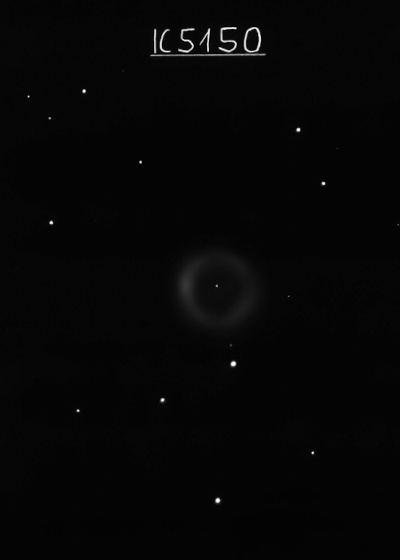
See IC 5148.
300/350mm - 13.1" (8/17/85): fairly faint with OIII at 79x, fairly large. Appears clearly annular with averted vision. The central hole is possibly elongated N-S. A mag 11 star is off the south edge. Similar view on 7/20/85.
400/500mm - 17.5" (10/30/99): Even at -39° declination, this moderately large planetary is a beautiful annular ring at 100x with an OIII filter. Appears round, ~100" diameter, the annulus has an irregular surface brightness. The central "hole" is perhaps 25" in diameter and fairly dark. A mag 10.5 star is close off the SSW edge.
17.5" (8/20/88): perfect annular 2' ring visible at 82x using an OIII filter. A mag 10.5 star is just off the SSW edge 1.8' from the center. The ring-shape is clearly visible with direct vision.
17.5" (7/22/87): beautiful ring at 140x with an OIII filter. Appears fairly large, fairly bright with a mag 11 star off the south edge.
900/1200mm - 48" (10/23/14): beautiful, large annular planetary at 375x, round, roughly 2' diameter, with a relatively thick annulus and a 30" central dark hole. Contains a very easy central star, which seems brighter than mag 16.5. The annulus is mottled and irregular in brightness. A 60° arc along the NW portion of the annulus is slightly brighter and a 90° arc from SE to NE is much brighter and a little thicker. A mag 10.5 star is off the SSW side (1.9' from center), but there are no superimposed stars.
Notes by Steve Gottlieb
NGC 7410
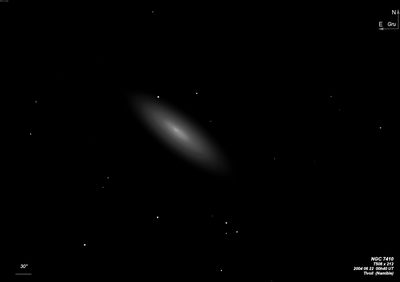
James Dunlop discovered NGC 7410 = D 518 = h3960 on 14 July 1826 and recorded "a very faint nebula extended preceding and following, about 1.5' long and 20 or 25 arcseconds broad; a little brighter in the middle, or rather nearer the N.p. extremity; the S.f. extremity is very ill defined." His position is 11' due east of the galaxy. John Herschel first observed this galaxy on 4 Sep 1834 and logged "B, pL, vmE in pos 41.9 degrees, pgmbM, 3' long, 20" broad, has a star 11m, 2' dist, pos from nucleus 12.9°." On a later sweep he wrote "a long pB ray, 4' long, psvmbM, elongated in pos 44.7°." His mean position is accurate.
200/250mm - 8" (7/16/82): faint, moderately large, very elongated SW-NE.
400/500mm - 17.5" (10/20/90): fairly bright, fairly large, elongated 3:1 SW-NE, well concentrated to a small very bright core, stellar nucleus. A mag 12 star is 1.8' NNE of center. Appears bright for such a far southern galaxy (observed from +38° latitude).
Notes by Steve Gottlieb
NGC 7552
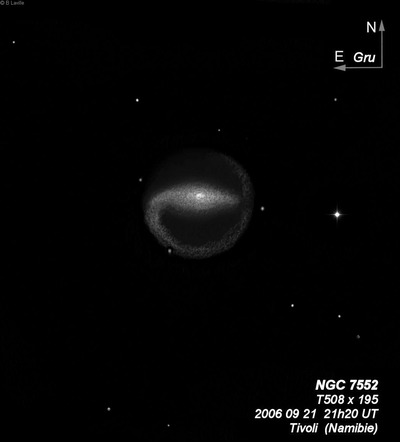
James Dunlop discovered NGC 7552 = D 475 = h3977 on 7 Jul 1826 and claimed 4 observations. He described the first member of the Grus Quartet as "a small faint nebula, rather elongated in the parallel of the equator, about 30" broad, and 40" long; there is a pretty bright point situated near the centre of the nebula: a small star precedes it."
John Herschel made a single observation on 2 Sep 1836, logging "B, S, mE, nearly in parallel; vsbM to a star 13m." Herschel credited Dunlop with the discovery. Lewis Swift found the galaxy again on 22 Oct 1897 and reported Sw. XI-226 (later IC 5294) as "pB; pS; R; 8m * p[receding] same parallel." His RA was just 9 seconds too small and his description of the brighter star clinches the equivalence.
Based on a Helwan plate taken in 1919-20, NGC 7552 was described as "vB sharp stellar nucleus; irregular Phi-type spiral; the cross-arm [central bar] is in p.a. 90° and is moderately bright at each end rather than near the middle, where a curious faint circle occurs of diameter 50"; the outer circle [ring] of the Phi is extremely faint except the southeast side."
300/350mm - 13.1" (11/5/83): fairly faint, small, elongated E-W, small bright nucleus. A mag 10 star lies 4.4' W and a mag 11 star is off the south side. The Grus trio consisting of NGC 7582, NGC 7590 and NGC 7599 are roughly 35' NE with the entire group called the Grus Quartet.
600/800mm - 30" (10/21/17 - OzSky): at 264x; very bright, very large, elongated 5:2 E-W, ~2.3'x0.9'. A brighter bar extends E-W along the major axis. The center is punctuated by a sharp, extremely bright stellar nucleus! A spiral arm was clearly visible attached at the east end of the major axis (bar). The beginning of the arm rotated counterclockwise towards the south but it shortly dimmed out after a distance ~0.6'. The main part of the galaxy is embedded in an extremely low surface brightness halo, ~3' in diameter. A mag 13.5 star is off the west end [2.2' from center] and a mag 12 star is at the edge of the outer halo [1.8' S of center]. NGC 7583, the first in the Grus Trio with 7590 and 7599, lies 28' ENE.
Notes by Steve Gottlieb
NGC 7412
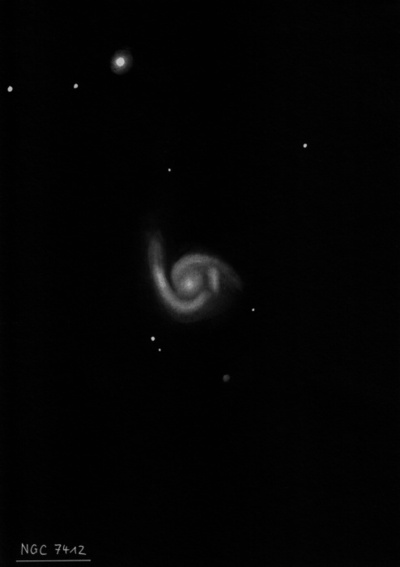
John Herschel discovered NGC 7412 = h3961 on 2 Sep 1836 and recorded "eF; vL; 3' diam at least; it is south-preceding a star 7m, 8' dist."
Based on a photo taken at the Helwan observatory in 1919-20, it was described as a "2-branched spiral with pF almost stellar nucleus and condensations; like the letter "S"."
300/350mm - 13.1" (9/3/86): faint, fairly large, very diffuse, elongated ~N-S. Located 6' SSW of mag 7.3 SAO 231361.
Notes by Steve Gottlieb
NGC 7462
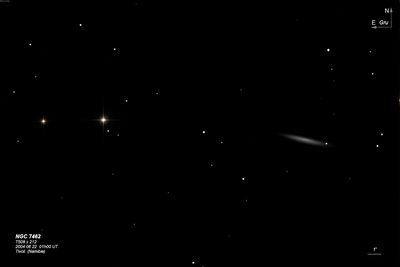
John Herschel discovered NGC 7462 = h3968 on 5 Sep 1834 and recorded "pB; S; vmE; has a *11m preceding its extremity." The mag 11 star at the west edge is MCG -07-47-012 (misclassified as a galaxy).
300/350mm - 13.1" (9/3/86): fairly faint, fairly small, pretty edge-on oriented ~E-W. A mag 11 star is at the west end and four other comparable stars including a nice double at 36" separation are within 5'. Located 10.6' W of mag 6.6 SAO 231415.
Notes by Steve Gottlieb
NGC 7496
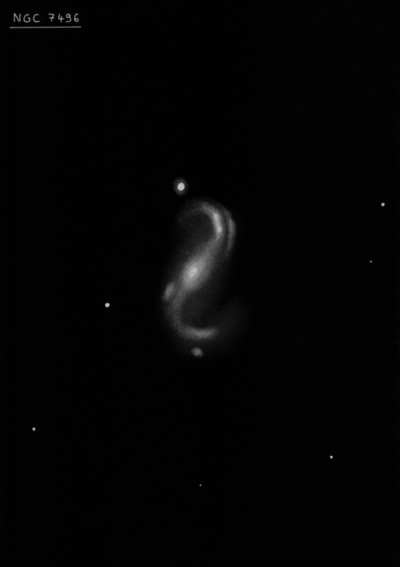
John Herschel discovered NGC 7496 = h3973 on 5 Sep 1834 and recorded "B; L; lE; vgmbM; to a * 13m."
400/500mm - 17.5" (10/20/90): faint, fairly small, oval 3:2 NNW-SSE, brighter core. A mag 10.5 star is off the north end 1.8' from center! Located 32' W of mag 4.3 Theta Gruis (V = 4.3).
Notes by Steve Gottlieb
NGC 7232
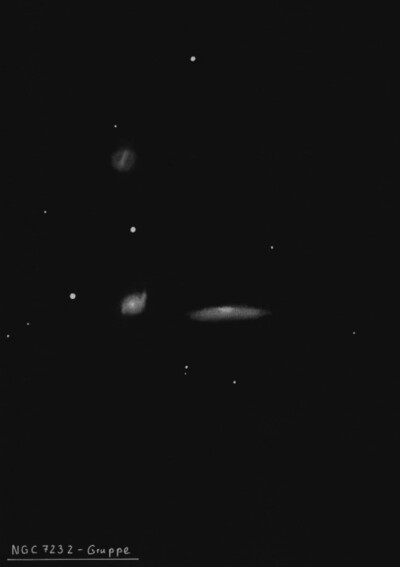
John Herschel discovered NGC 7232 = h3931, along with NGC 7233, on 6 Sep 1834 and recorded "pB; vS; pmE; psbM; 15" l, 8" br. The preceding of 2."
300/350mm - 13.1" (8/17/85): faint, elongated WNW-ESE, brighter core. Located just 3.0' SW of mag 8.5 SAO 231056 and 3.0' W of a mag 9.5 star. Brighter IC 5181 lies 26' SW. Very far south for viewing from the latitude of Northern California.
400/500mm - 18" (7/5/05 - Magellan Observatory, Australia): moderately bright, moderately large, elongated 5:2 ~E-W, ~1.5'x0.6'. Well concentrated with a bright 30" core. Forms the western vertex of an isosceles triangle with two bright stars – mag 8.8 HD 211111 3' NE and mag 8.9 HD 211121 3.5' E. To complete this striking arrangement, a fainter companion, NGC 7233 is 1.9' E and is squeezed between NGC 7232 and the mag 8.9 star nearly due east. Observation made with a partially dewed secondary that probably dimmed both members.
Notes by Steve Gottlieb
NGC 7249
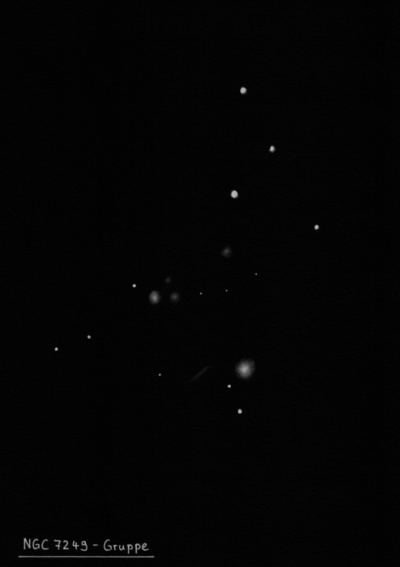
John Herschel discovered NGC 7249 = h3933 on 4 Oct 1834 and recorded "eeF; R; rather a doubtful object." Despite his doubts, his position is within 1' of ESO 190-001 = PGC 68606, the brightest member of AGC 3869.
600/800mm - 25" (10/10/15 - OzSky): at 318x; fairly faint, fairly small, round, 0.4' diameter, weak concentration. Forms a pair with PGC 95403 = 2MASX J22204571-5506093, just 2.5' NE. The companion was logged as very faint, small, 15" diameter. A mag 15.5-15.8 star is 0.4' NE. These are the two brightest members of the southern cluster AGC 3869.
Notes by Steve Gottlieb
IC 5170
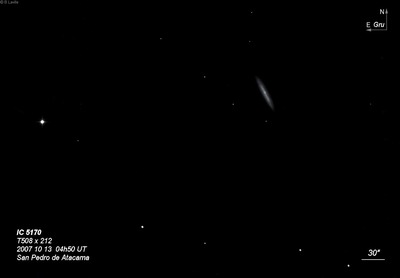
| Type | GX [SBa] |
| descr | Two entries for IC 5170 in ESO and ESO-LV. |
| RA | 22:12:29.6 |
| Dec | -47:13:17.0 |
| major_axis | 1.8' |
| minor_axis | 48.0'' |
| position_angle | 26.0 |
| mag | 12.5 |
| surface_bright | 12.6 |